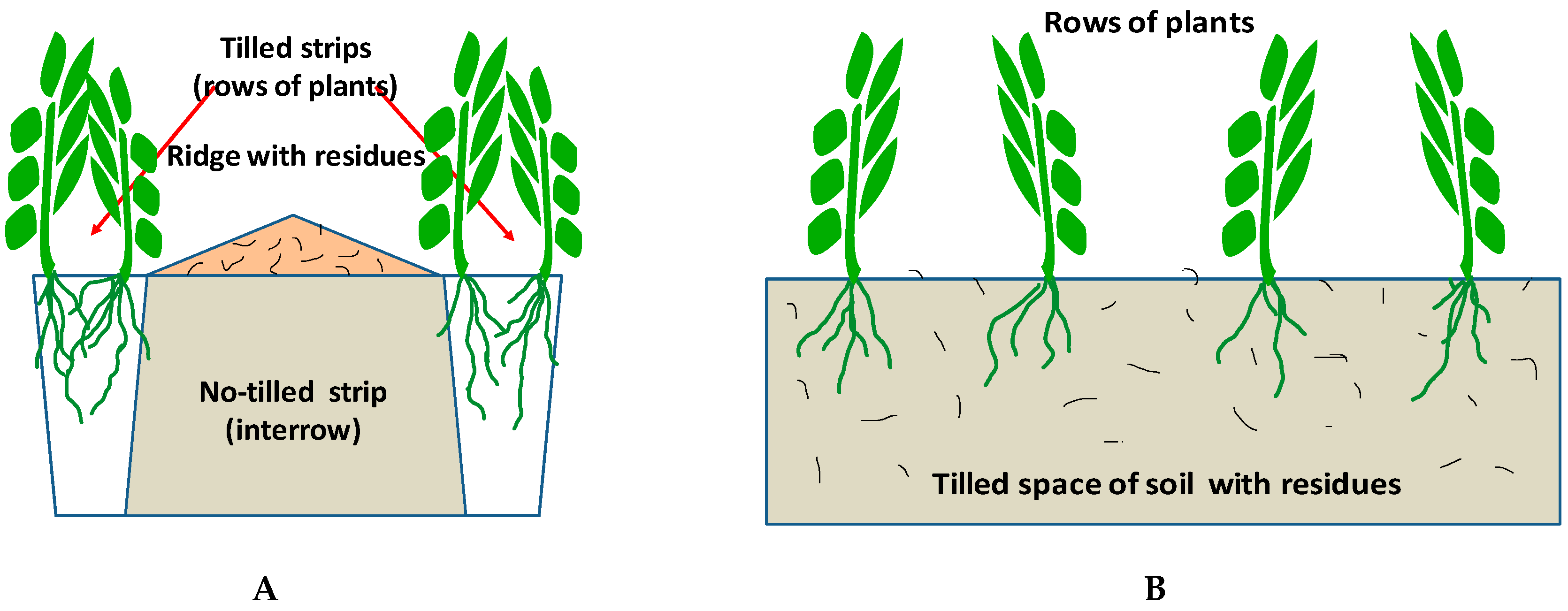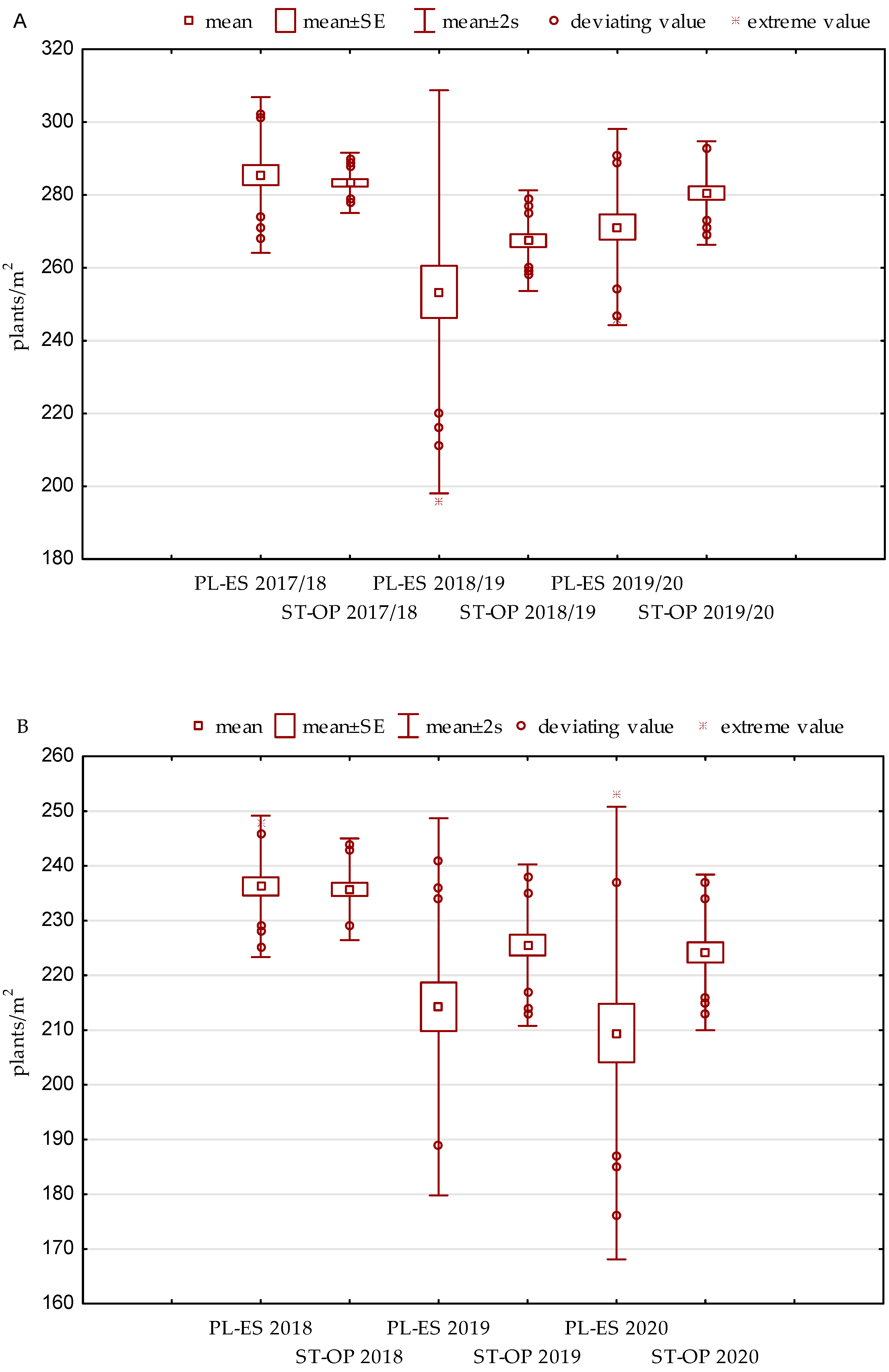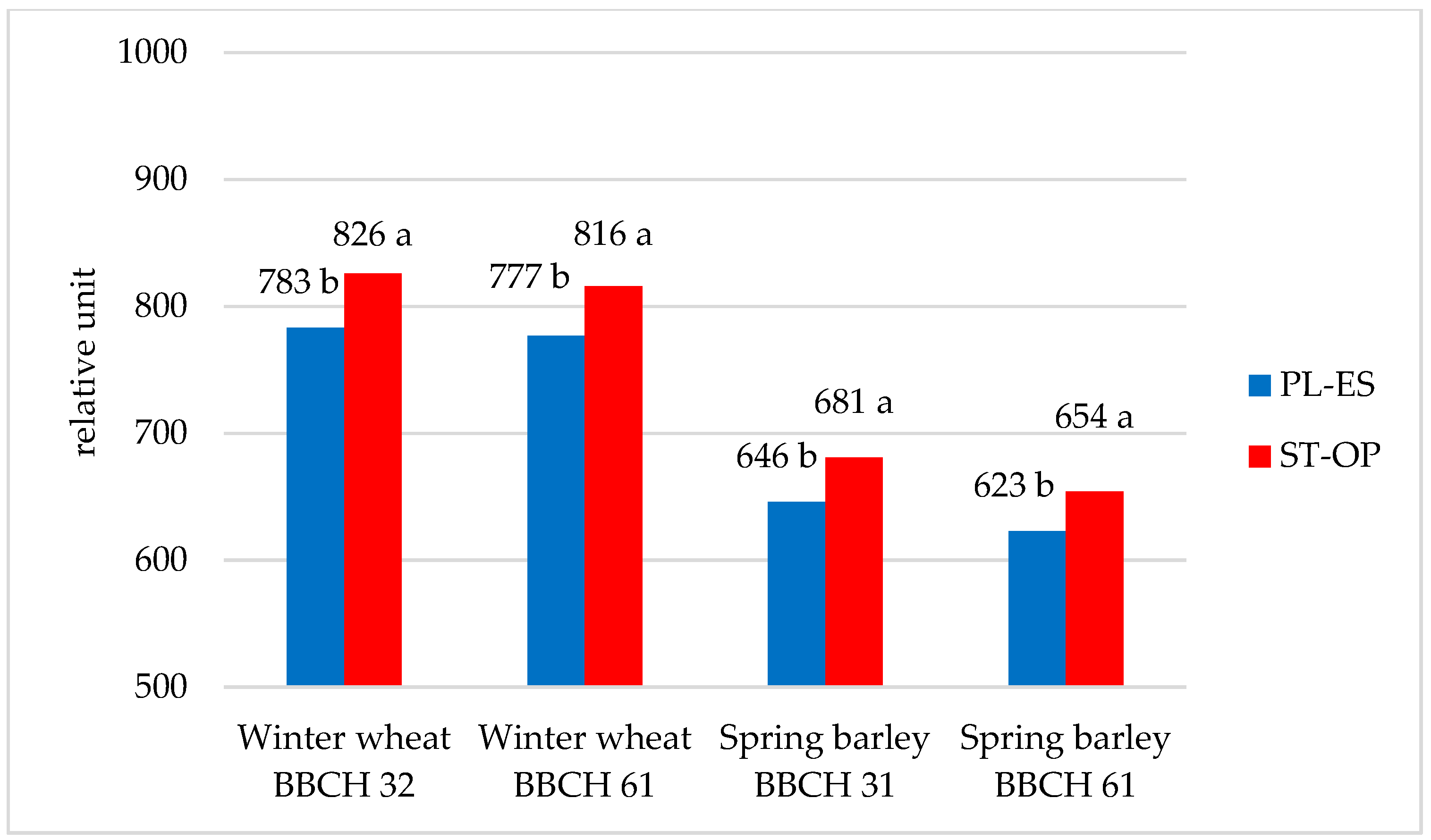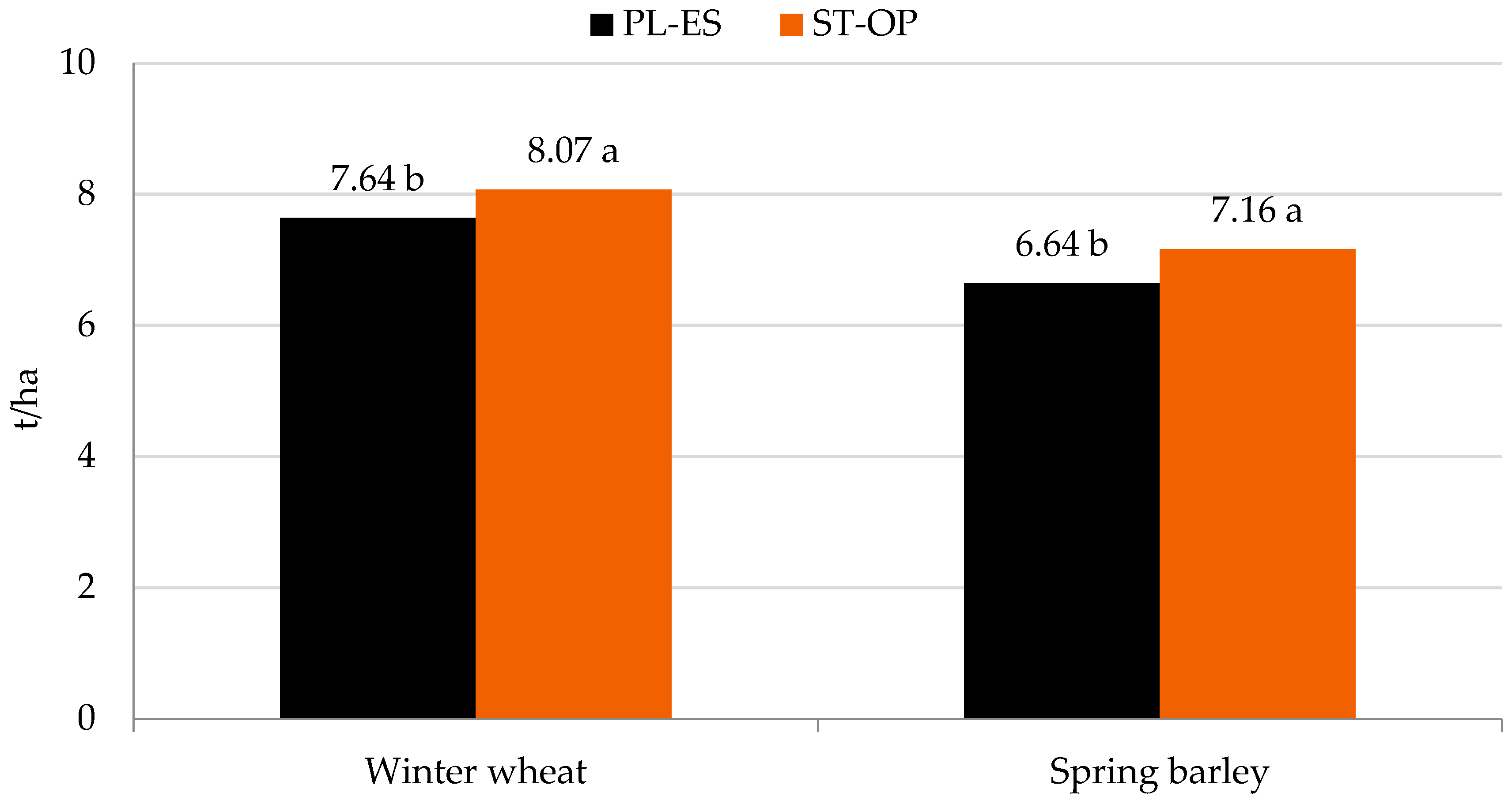Winter Wheat and Spring Barley Canopies under Strip-Till One-Pass Technology
Abstract
:1. Introduction
2. Materials and Methods
2.1. Research Location and Period
2.2. Field Experiments
2.3. Sampling and Measurement
2.4. Data Analysis
3. Results
4. Discussion
5. Conclusions
Author Contributions
Funding
Acknowledgments
Conflicts of Interest
References
- Porwollik, V.; Rolinski, S.; Heinke, J.; Müller, C. Generating a rule-based global gridded tillage dataset. Earth Syst. Sci. Data 2019, 11, 823–843. [Google Scholar] [CrossRef] [Green Version]
- Kassam, A.; Friedrich, T.; Derpsch, R. Global spread of conservation agriculture. Int. J. Environ. Stud. 2019, 76, 29–51. [Google Scholar] [CrossRef]
- Erb, K.H.; Luyssaert, S.; Meyfroidt, P.; Pongratz, J.; Don, A.; Kloster, S.; Kuemmerle, T.; Fetzel, T.; Fuchs, R.; Herold, M.; et al. Land management: Data availability and process understanding for global change studies. Glob. Chang. Biol. 2016, 23, 512–533. [Google Scholar] [CrossRef] [PubMed] [Green Version]
- Townsend, T.J.; Ramsden, S.J.; Wilson, P. How do we cultivate in England? Tillage practices in crop production systems. Soil Use Manag. 2016, 32, 106–117. [Google Scholar] [CrossRef] [PubMed] [Green Version]
- Alskaf, K.; Sparkes, D.L.; Mooney, S.J.; Sjögersten, S.; Wilson, P. The uptake of different tillage practices in England. Soil Use Manag. 2020, 36, 27–44. [Google Scholar] [CrossRef]
- Twizerimana, A.; Niyigaba, E.; Mugenzi, I.; Ngnadong, W.A.; Li, C.; Hao, T.Q.; Shio, B.J.; Hai, J.B. The Combined Effect of Different Sowing Methods and Seed Rates on the Quality Features and Yield of Winter Wheat. Agriculture 2020, 10, 153. [Google Scholar] [CrossRef]
- Abdus-Subhan; Khan, Q.; Mansoor, M.; Khan, M.J.; Ammanullah; Khan, M. Response of Wheat to tillage and sowing techniques under arid condition. Pak. J. Agric. Res. 2017, 30, 136–143. [Google Scholar] [CrossRef]
- Mitchell, J.P.; Carter, L.M.; Reicosky, D.C.; Shrestha, A.; Pettygrove, G.S.; Klonsky, K.M.; Marcum, D.B.; Chessman, D.; Royi, R.; Hogan, P.; et al. A history of tillage in California’s Central Valley. Soil Tillage Res. 2016, 157, 52–64. [Google Scholar] [CrossRef]
- Morris, N.L.; Miller, P.C.H.; Orson, J.H.; Froud-Williams, R.J. The adoption of noninversion tillage systems in the United Kingdom and the agronomic impact on soil, crops and the environment—A review. Soil Tillage Res. 2010, 108, 1–15. [Google Scholar] [CrossRef]
- Benincasa, P.; Zorzi, A.; Panella, F.; Tosti, G.; Trevini, M. Strip tillage and sowing: Is precision planting indispensable in silage maize? Int. J. Plant Prod. 2017, 11, 577–588. [Google Scholar]
- Morrison Jr, J.E.; Sanabria, J. One-pass and two-pass spring strip tillage for conservation row-cropping in adhesive clay soils. Trans. ASABE 2002, 45, 1263–1270. [Google Scholar] [CrossRef]
- Mzuri. The Complete Strip Tillage System. Available online: http://mzuri.eu/wpcontent/uploads/MzuriBrochure-2017.pdf (accessed on 12 May 2020).
- Williams, A.; Kane, D.A.; Ewing, P.M.; Atwood, L.W.; Jilling, A.; Li, M.; Lou, Y.; Davis, A.S.; Grandy, A.S.; Huerd, S.C.; et al. Soil functional zone management: A vehicle for enhancing production and soil eco-system services in row-crop agroecosystems. Front. Plant Sci. 2016, 7, 65. [Google Scholar] [CrossRef] [PubMed] [Green Version]
- Fernández, F.G.; Sorensen, B.A.; Villamil, M.B. A comparison of soil properties after five years of no-till and strip-till. Agron. J. 2015, 107, 1339–1346. [Google Scholar] [CrossRef]
- Laufer, D.; Loibl, B.; Märländer, B.; Koch, H.J. Soil erosion and surface runoff under strip tillage for sugar beet (Beta vulgaris L.) in Central Europe. Soil Tillage Res. 2016, 162, 1–7. [Google Scholar] [CrossRef]
- Jaskulska, I.; Jaskulski, D. Strip-Till One-Pass Technology in Central and Eastern Europe: A MZURI Pro-Til Hybrid Machine Case Study. Agronomy 2020, 10, 925. [Google Scholar] [CrossRef]
- Senger, M.; Zagonel, J.; Ferreira, C.; de Souza, A.C.; Zardo-Filho, R. Influence of wheat populations arrangement on growth characteristics and grain yield. Afr. J. Agric. Res. 2015, 10, 4937–4944. [Google Scholar]
- Mao, X.M.; Zhong, W.W.; Wang, X.Y.; Zhou, X.B. Effects of precision planting patterns and irrigation on winter wheat yields and water productivity. J. Agric. Sci. 2017, 155, 1394–1406. [Google Scholar] [CrossRef]
- Bellaloui, N.; Bruns, H.A.; Abbas, H.K.; Mengistu, A.; Fisher, D.K.; Reddy, K.N. Effects of Row-Type, Row-Spacing, Seeding Rate, Soil-Type, and Cultivar Differences on Soybean Seed Nutrition under US Mississippi Delta Conditions. PLoS ONE 2015, 10, e0129913. [Google Scholar] [CrossRef]
- Zhou, X.B.; Wang, G.Y.; Yang, L.; Wu, H.Y. Double-Double Row Planting Mode at Deficit Irrigation Regime Increases Winter Wheat Yield and Water Use Efficiency in North China Plain. Agronomy 2020, 10, 1315. [Google Scholar] [CrossRef]
- Bhunia, S.R.; Verma, I.M.; Arif, M.; Gochar, R.; Sharma, N.C. Effect of crop geometry, drip irrigation and bio-regulator on growth, yield and water use efficiency of wheat (Triticum aestivum L.). Int. J. Agric. Sci. 2015, 11, 45–49. [Google Scholar] [CrossRef]
- Monostori, I.; Heilmann, M.; Kocsy, G.; Rakszegi, M.; Ahres, M.; Altenbach, S.B.; Szalai, G.; Pál, M.; Toldi, D.; Simon-Sarkadi, L.; et al. LED Lighting—Modification of growth, metabolism, yield and flour composition in wheat by spectral quality and intensity. Front. Plant Sci. 2018, 9, 605. [Google Scholar] [CrossRef] [PubMed]
- Emmel, C.; D’Odorico, P.; Revill, A.; Hörtnagl, L.; Ammann, C.; Buchmann, N.; Eugster, W. Canopy photosynthesis of six major arable crops is enhanced under diffuse light due to canopy architecture. Glob. Chang. Biol. 2020, 26, 5164–5177. [Google Scholar] [CrossRef] [PubMed]
- Barillot, R.; Chambon, C.; Fournier, C.; Combes, D.; Pradal, C.; Andrieu, B. Investigation of complex canopies with a functional-structural plant model as exemplified by leaf inclination effect on the functioning of pure and mixed stands of wheat during grain filling. Ann Bot. 2019, 123, 727–742. [Google Scholar] [CrossRef]
- Li, D.; Zhang, D.; Wang, H.; Li, H.; Fang, Q.; Li, H.; Li, R. Optimized planting density maintains high wheat yield under limiting irrigation in North China Plain. Int. J. Plant Prod. 2020, 14, 107–117. [Google Scholar] [CrossRef]
- Pandey, B.; Basnet, K.; Bhatta, M.; Sah, S.; Thapa, R.; Kandel, T. Effect of row spacing and direction of sowing on yield and yield attributing characters of wheat cultivated in Western Chitwan, Nepal. J. Agric. Sci. 2013, 4, 309–316. [Google Scholar] [CrossRef] [Green Version]
- Hussain, M.; Waqas-Ul-Haq, M.; Farooq, S.; Jabran, K.; Farroq, M. The impact of seed priming and row spacing on the productivity of different cultivars of irrigated wheat under early season drought. Exp. Agric. 2016, 52, 477–490. [Google Scholar] [CrossRef] [Green Version]
- Hussain, M.; Khan, M.B.; Mehmood, Z.; Zia, A.B.; Jabran, K.; Farooq, M. Optimizing row spacing in wheat cultivars differing in tillering and stature for higher productivity. Arch. Agron. Soil Sci. 2013, 59, 1457–1470. [Google Scholar] [CrossRef]
- Novacek, M.J.; Mason, S.C.; Galusha, T.D.; Yaseen, M. Twin-rows minimally impact irrigated maize yield, morpholog y and lodging. Agron. J. 2013, 105, 26–8276. [Google Scholar] [CrossRef]
- Fischer, R.A.; Ramos, O.H.M.; Monasterio, I.O.; Sayre, K.D. Yield response to plant density, row spacing and raised beds in low latitude spring wheat with ample soil resources: An update. Field Crops Res. 2019, 232, 95–105. [Google Scholar] [CrossRef]
- Abichou, M.; de Solan, B.; Andrieu, B. Architectural response of wheat cultivars to row spacing reveals altered perception of plant density. Front. Plant Sci. 2019, 10, 999. [Google Scholar] [CrossRef] [Green Version]
- Liu, T.; Wang, Z.; Cai, T. Canopy Apparent Photosynthetic Characteristics and Yield of Two Spike-Type Wheat Cultivars in Response to Row Spacing under High Plant Density. PLoS ONE 2016, 11, e0148582. [Google Scholar] [CrossRef] [PubMed] [Green Version]
- Bastos, L.M.; Carciochi, W.; Lollato, R.P.; Jaenisch, B.R.; Renzende, C.R.; Schwalbert, R.; Prasad, P.V.V.; Zhang, G.; Frotz, A.K.; Foster, C.; et al. Winter wheat yield response to plant density as a function of yield environment and tillering potential: A review and field studies. Front. Plant Sci. 2020, 11, 1–17. [Google Scholar] [CrossRef] [Green Version]
- Hussain, M.; Farooq, S.; Jabran, K.; Ijaz, M.; Sattar, A.; Hassan, W. Wheat Sown with Narrow Spacing Results in Higher Yield and Water Use Efficiency under Deficit Supplemental Irrigation at the Vegetative and Reproductive Stage. Agronomy 2016, 6, 22. [Google Scholar] [CrossRef]
- Giraldo, P.; Benavente, E.; Manzano-Agugliaro, F.; Gimenez, E. Worldwide Research Trends on Wheat and Barley: A Bibliometric Comparative Analysis. Agronomy 2019, 9, 352. [Google Scholar] [CrossRef] [Green Version]
- Reicosky, D.C. Conservation tillage is not conservation agriculture. J. Soil Water Conserv. 2015, 70, 103A–108A. [Google Scholar] [CrossRef] [Green Version]
- Williams, A.; Davis, A.S.; Ewing, P.M.; Grandy, A.S.; Kane, D.A.; Koide, R.T.; Mortensen, D.A.; Smith, R.G.; Snapp, S.S.; Spokas, K.A.; et al. A comparison of soil hydrothermal properties in zonal and uniform tillage systems across the US Corn Belt. Geoderma 2016, 273, 12–19. [Google Scholar] [CrossRef] [Green Version]
- Cociu, A. Tillage system effects on input efficiency of winter wheat, maize and soybean in rotation. Rom. Agric. Res. 2010, 27, 81–89. [Google Scholar]
- Šarauskis, E.; Vaitauskienė, K.; Romaneckas, K.; Jasinskas, A.; Butkus, V.; Kriaučiūnienė, Z. Fuel consumption and CO2 emission analysis in different strip tillage scenarios. Energy 2017, 118, 957–968. [Google Scholar] [CrossRef]
- WRB. World Reference Base for Soil Resources 2014. In International Soil Classification System for Naming Soils and Creating Legends for Soil Maps; IUSS Working Group WRB, World Soil Resources Reports No. 106; FAO: Rome, Italy, 2014. [Google Scholar]
- Peel, M.C.; Finlayson, B.L.; McMahon, T.A. Updated world map of the Köppen-Geiger climate classification. Hydrol. Earth Syst. Sci. 2007, 11, 1633–1644. [Google Scholar] [CrossRef] [Green Version]
- Kuśmierek-Tomaszewska, R.; Dudek, S.; Żarski, J.; Januszewska-Klapa, K. Temporal variability of drought in field crops in the region of Kujawsko-Pomorskie, Poland. Res. Rural Dev. 2018, 2, 62–68. [Google Scholar]
- Statistica. Data Analysis Software System, Version 12; TIBCO Software INC: Palo Alto, CA, USA, 2017; Available online: http://statistica.io (accessed on 15 January 2019).
- Hossain, M.I.; Haque, M.E.; Meisner, C.A.; Sufian, M.A.; Rahman, M.M. Strip tillage planting method for better wheat establishment. J. Sci. Technol. 2005, 3, 91–95. [Google Scholar]
- Jaskulska, I.; Gałązka, A.; Jaskulski, D. Strip-till as a means of decreasing spatial variability of winter barley within a field scale. Acta Agric. Scand. B-SP 2019, 69, 516–527. [Google Scholar] [CrossRef]
- Jaskulska, I.; Jaskulski, D.; Różniak, M.; Radziemska, M.; Gałęzewski, L. Zonal tillage as innovative element of the technology of growing winter wheat: A field experiment under low rainfall conditions. Agriculture 2020, 10, 105. [Google Scholar] [CrossRef] [Green Version]
- He, J.; Shi, Y.; Zhao, J.; Yu, Z. Strip rotary tillage with a two-year subsoiling interval enhances root growth and yield in wheat. Sci. Rep. 2019, 9, 11678. [Google Scholar] [CrossRef] [Green Version]
- Hoque, M.; Miah, M.S. Evaluation of different tillage methods to assess BARI inclined plate planter. Agric. Eng. Int. 2015, 17, 128–137. [Google Scholar]
- Alvarez, R.; Steinbach, H.S. A review of the effects of tillage systems on some soil physical properties, water content, nitrate availability and crops yield in the Argentine Pampas. Soil Tillage Res. 2009, 104, 1–15. [Google Scholar] [CrossRef]
- Hossain, M.I.; Gathala, M.K.; Tiwari, T.P.; Hossain, M.S. Strip tillage seeding technique: A better option for utilizing residual soil moisture in rainfed moisture stress environments of North-West Bangladesh. Int. J. Recent Dev. Eng. Technol. 2014, 2, 132–136. [Google Scholar]
- Hasan, M.; Mahmud, K.; Islam, M.N.; Sarkar, P.K.; Shariot-Ullah, M. Water productivity and yield performances of wheat under different irrigation and tillage treatments. Fundam. Appl. Agric. 2017, 2, 196–201. [Google Scholar]
- Gałęzewski, L.; Jaskulska, I.; Wilczewski, E.; Wenda-Piesik, A. Response of Yellow Lupine to the Proximity of Other Plants and Unplanted Path in Strip Intercropping. Agriculture 2020, 10, 285. [Google Scholar] [CrossRef]
- Celik, A.; Altikat, S.; Way, T.R. Strip tillage width effects on sunflower seed emergence and yield. Soil Tillage Res. 2013, 131, 20–27. [Google Scholar] [CrossRef]
- Tabatabaeekoloor, R. Soil characteristics at the in-row and inter-row zones after strip-tillage. Afr. J. Agric. Res. 2011, 6, 6598–6603. [Google Scholar] [CrossRef]
- Overstreet, L.F.; Hoyt, G.D. Effects of strip-tillage and production inputs on soil biology across a spatial gradient. Soil Sci. Soc. Am. J. 2008, 72, 1454–1463. [Google Scholar] [CrossRef] [Green Version]
- Fernández, F.G.; White, C. No-till and strip-till corn production with broadcast and subsurface-band phosphorus and potassium. Agron. J. 2012, 104, 996–1005. [Google Scholar] [CrossRef]
- Jaskulska, I.; Romaneckas, K.; Jaskulski, D.; Gałęzewski, L.; Breza-Boruta, B.; Dębska, B.; Lemanowicz, J. Soil Properties after Eight Years of the Use of Strip-Till One-Pass Technology. Agronomy 2020, 10, 1596. [Google Scholar] [CrossRef]
- Celik, A.; Ozturk, I.; Way, T.R. Effects of various planters on emergence and seed distribution uniformity of sunflower. Appl. Eng. Agric. 2007, 23, 57–61. [Google Scholar] [CrossRef]
- Song, X.; Yang, G.; Yang, C.; Wang, J.; Cui, B. Spatial variability analysis of within-field winter wheat nitrogen and grain quality using canopy fluorescence sensor measurements. Remote Sens. 2017, 9, 237. [Google Scholar] [CrossRef] [Green Version]
- Masino, A.; Rugeroni, P.; Borrás, L.; Rotundo, J.L. Spatial and temporal plant-to-plant variability effects on soybean yield. Eur. J. Agron. 2018, 98, 14–24. [Google Scholar] [CrossRef]
- Jaskulska, I.; Gałęzewski, L.; Piekarczyk, M.; Jaskulski, D. Strip-till technology—A method for uniformity in the emergence and plant growth of winter rapeseed (Brassica napus L.) in different environmental conditions of Northern Poland. Ital. J. Agron. 2018, 13, 194–199. [Google Scholar] [CrossRef]
- Goins, G.D.; Yorio, N.C.; Sanwo, M.M.; Brown, C.S. Photomorphogenesis, photosynthesis, and seed yield of wheat plants grown under red light-emitting diodes (LEDs) with and without supplemental blue lighting. J. Exp. Bot. 1997, 48, 1407–1413. [Google Scholar] [CrossRef] [Green Version]
- Sparkes, D.L.; King, M. Disentangling the effects of PAR and R: FR on lodging-associated characters of wheat. Ann. Appl. Biol. 2008, 152, 1–9. [Google Scholar] [CrossRef]
- Shah, A.N.; Tanveer, M.; ur Rehman, A.; Anjum, S.A.; Iqbal, J.; Ahmad, R. Lodging stress in cereal—Effects and management: An overview. Environ. Sci. Pollut. Res. 2017, 24, 5222–5237. [Google Scholar] [CrossRef] [PubMed]
- Khobra, L.; Sereen, S.; Meena, B.K.; Kumar, A.; Tivari, V.; Singh, G.P. Exploring the traits for lodging tolerance in wheat genotypes: A review. Physiol. Mol. Biol. Plants 2019, 25, 589–600. [Google Scholar] [CrossRef]
- Zhang, L.; Hu, Z.; Fan, J.; Zhou, D.; Tang, F. A meta-analysis of the canopy light extinction coefficient in terrestrial ecosystems. Front. Earth Sci. 2014, 8, 599–609. [Google Scholar] [CrossRef]
- Burgess, A.J.; Retkute, R.; Herman, T.; Murchie, E.H. Exploring relationships between canopy architecture, light distribution, and photosynthesis in contrasting rice genotypes using 3D canopy reconstruction. Front. Plant Sci. 2017, 8, 734. [Google Scholar] [CrossRef]
- Khabiri, E.; Jafari, M. The effect of different light levels on the growth of wheat gascogne. Int. Res. J. Appl. Basic Sci. 2012, 3, 2358–2363. [Google Scholar]
- Pradhan, S.; Sehgal, V.K.; Bandyopadhyay, K.K.; Panigrahi, P.; Parihar, C.M.; Jat, S.L. Radiation interception, extinction coefficient and use efficiency of wheat crop at various irrigation and nitrogen levels in a semi-arid location. Ind. J. Plant. Physiol. 2018, 23, 416–425. [Google Scholar] [CrossRef] [Green Version]
- Elli, E.F.; Caron, B.O.; Medeiros, S.L.P.; Eloy, E.; Monteiro, G.C.; Schmidt, D. Effects of growth reducer and nitrogen fertilization on morphological variables, SPAD index, interception of radiation and productivity of wheat. Rev. Ceres. 2015, 62, 577–582. [Google Scholar] [CrossRef] [Green Version]





| Property | 2017/2018 | 2018/2019 | 2019/2020 |
|---|---|---|---|
| Texture (%): | |||
| sand (2–0.05 mm) | 52.3 | 50.5 | 47.8 |
| silt (0.05–0.002 mm) | 43.6 | 44.5 | 48.4 |
| clay (<0.002 mm) | 4.1 | 5.0 | 3.8 |
| pHKCl | 6.41 | 6.17 | 6.30 |
| Organic carbon (g C/kg soil) | 9.34 | 9.51 | 9.17 |
| Total nitrogen (g N/kg soil) | 0.97 | 0.94 | 1.03 |
| Available nutrients: | |||
| phosphorus (mg P/kg soil) | 84.3 | 74.7 | 82.1 |
| potassium (mg K/kg soil) | 173.6 | 194.1 | 203.4 |
| magnesium (mg Mg/kg soil) | 54.9 | 67.3 | 54.4 |
| Month | 2017 | 2018 | 2019 | 2020 | Many-Year | 2017 | 2018 | 2019 | 2020 | Many-Year |
|---|---|---|---|---|---|---|---|---|---|---|
| Air Temperature (°C) | Precipitation (mm) | |||||||||
| January | - | 0.8 | −0.7 | 2.6 | −1.8 | - | 46.3 | 32.6 | 37.7 | 26.8 |
| February | - | −3.2 | 2.6 | 3.6 | −0.9 | - | 5.8 | 18.1 | 36.0 | 20.7 |
| March | - | −0.2 | 5.4 | 3.9 | 2.5 | - | 16.4 | 28.8 | 26.1 | 31.9 |
| April | - | 12.0 | 9.3 | 8.2 | 7.9 | - | 40.4 | 1.5 | 0.7 | 27.0 |
| May | - | 16.9 | 12.1 | 11.2 | 13.3 | - | 14.2 | 89.2 | 34.2 | 49.3 |
| June | - | 18.4 | 21.9 | 17.9 | 16.1 | - | 26.4 | 17.7 | 142.0 | 52.8 |
| July | - | 20.5 | 18.6 | 18.3 | 18.6 | - | 86.0 | 22.4 | 67.2 | 69.8 |
| August | - | 19.9 | 19.7 | 19.9 | 17.9 | - | 23.7 | 37.7 | 114.4 | 62.6 |
| September | 13.0 | 15.6 | 13.5 | - | 13.1 | 78.4 | 17.0 | 98.5 | - | 46.0 |
| October | 10.1 | 9.8 | 9.8 | - | 8.2 | 106.8 | 34.1 | 35.9 | - | 31.5 |
| November | 4.5 | 4.5 | 5.5 | - | 2.9 | 30.5 | 7.2 | 69.6 | - | 32.4 |
| December | 2.0 | 2.0 | 2.7 | - | −0.6 | 38.8 | 50.3 | 21.1 | - | 34.0 |
| Average/Sum | - | 9.8 | 10.0 | - | 8.1 | - | 367.8 | 473.1 | - | 484.8 |
| Feature | Winter Wheat | Spring Barley | ||
|---|---|---|---|---|
| PL-ES | ST-OP | PL-ES | ST-OP | |
| Plant height (cm) | 91.5 a | 88.4 b | 65.1 a | 62.7 b |
| Spike density (no/m2) | 540.1 b | 572.7 a | 641.6 b | 679.3 a |
| Grains per spike | 34.8 b | 35.9 a | 23.8 b | 25.3 a |
| Grain weight per spike (g) | 1.57 b | 1.64 a | 1.05 b | 1.12 a |
| Thousand grain weight (g) | 44.4 ns | 44.6 ns | 43.6 ns | 43.9 ns |
| BBCH Stage | PL-ES | ST-OP | |||
|---|---|---|---|---|---|
| IR-N | R-PD | IR-N | IR-W | R-PD | |
| Winter wheat | |||||
| 32 | 2.01 ab | 1.83 bc | 2.09 a | 0.70 d | 1.66 c |
| 61 | 4.65 a | 4.22 b | 4.73 a | 3.58 c | 4.19 b |
| Spring barley | |||||
| 31 | 1.79 a | 1.64 b | 1.85 a | 0.85 c | 1.52 b |
| 61 | 3.53 a | 3.38 bc | 3.51 a | 3.28 c | 3.41 ab |
| BBCH Stage | PL-ES | ST-OP | |||
|---|---|---|---|---|---|
| IR-N | R-PD | IR-N | IR-W | R-PD | |
| Winter wheat—2017/18 | |||||
| 32 | 79.8 a | 74.8 b | 80.3 a | 47.4 d | 70.3 c |
| 61 | 92.9 a | 88.8 b | 95.1 a | 85.5 c | 86.9 bc |
| Spring barley—2018 | |||||
| 31 | 78.2 a | 70.9 b | 77.6 a | 54.6 c | 69.2 b |
| 61 | 87.1 a | 83.4 c | 86.3 ab | 82.4 c | 84.5 bc |
| Winter wheat—2018/19 | |||||
| 32 | 82.9 a | 76.4 b | 83.2 a | 68.9 d | 73.1 c |
| 61 | 95.6 a | 92.0 b | 96.4 a | 88.6 c | 92.7 b |
| Spring barley—2019 | |||||
| 31 | 79.5 a | 76.6 bc | 77.8 ab | 55.8 d | 74.9 c |
| 61 | 91.3 a | 87.4 bc | 89.9 ab | 83.8 d | 85.1 cd |
| Winter wheat—2019/20 | |||||
| 32 | 83.3 ab | 80.6 bc | 85.1 a | 66.8 d | 78.7 c |
| 61 | 92.3 ab | 91.6 bc | 93.2 a | 86.7 d | 90.9 c |
| Spring barley—2020 | |||||
| 31 | 78.4 ab | 77.3 ab | 81.1 a | 62.2 c | 74.5 b |
| 61 | 86.3 a | 83.2 ab | 85.2 ab | 82.0 b | 84.1 ab |
| Winter wheat—2017/18–2019/20 | |||||
| 32 | 82.0 a | 77.3 a | 82.9 a | 61.0 b | 74.0 a |
| 61 | 93.6 ab | 90.8 b | 94.9 a | 86.9 c | 90.2 bc |
| Spring barley—2018–2020 | |||||
| 31 | 76.7 a | 74.9 ab | 78.9 a | 57.5 c | 72.9 b |
| 61 | 88.2 a | 84.5 bc | 87.1 ab | 82.7 c | 85.6 ab |
Publisher’s Note: MDPI stays neutral with regard to jurisdictional claims in published maps and institutional affiliations. |
© 2021 by the authors. Licensee MDPI, Basel, Switzerland. This article is an open access article distributed under the terms and conditions of the Creative Commons Attribution (CC BY) license (http://creativecommons.org/licenses/by/4.0/).
Share and Cite
Jaskulska, I.; Jaskulski, D. Winter Wheat and Spring Barley Canopies under Strip-Till One-Pass Technology. Agronomy 2021, 11, 426. https://doi.org/10.3390/agronomy11030426
Jaskulska I, Jaskulski D. Winter Wheat and Spring Barley Canopies under Strip-Till One-Pass Technology. Agronomy. 2021; 11(3):426. https://doi.org/10.3390/agronomy11030426
Chicago/Turabian StyleJaskulska, Iwona, and Dariusz Jaskulski. 2021. "Winter Wheat and Spring Barley Canopies under Strip-Till One-Pass Technology" Agronomy 11, no. 3: 426. https://doi.org/10.3390/agronomy11030426
APA StyleJaskulska, I., & Jaskulski, D. (2021). Winter Wheat and Spring Barley Canopies under Strip-Till One-Pass Technology. Agronomy, 11(3), 426. https://doi.org/10.3390/agronomy11030426






